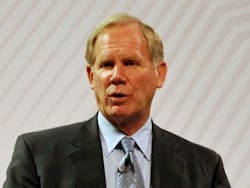Living on the edge: Consumers driving power grid dynamics
Innovation at the edge of the grid is changing the relationship between utilities and their customers. Renewables and electric vehicles (EV) are only the beginning.
“Solar always rises faster than we anticipate. And the energy storage price curve is amazing—soon it will be commonplace,” said Rob Caldwell, president, Renewables and Distributed Energy Technology, Duke Energy. “More new homes will be net-zero homes because the cost is becoming much lower, so it will be built in at the front end. Technology is going to do more than we realize, and faster, but this will not happen for everybody. There will remain a mismatch of customers.”
Caldwell joined Tom Rowland-Rees, lead analyst, Energy Smart Technologies, Bloomberg and Tarak Mehta, president, Electrification Products Division, ABB in a panel discussion moderated by Greg Scheu, Americas Region president, ABB, at ABB Customer World this week in Houston.
“When we first started looking at this space in 2004, there was 20 GW of wind and solar combined in our portfolio. That rose to 147 GW in 2015, representing an investment of $349 billion,” said Rowland-Rees. “Renewables are growing at a phenomenal rate, and they’re moving away from utility-scale generation with the rise of distributed solar. We expected rooftop solar to grow depending on the region. And that growth is always exceeding our forecasts.”
Duke Energy’s territory in the southeast U.S. now has 3,000 MW of solar power and 13,000 customers who are solar generators. In North Carolina, more generators want to connect more renewables in remote locations. “They don’t realize the affect on the grid. That’s a farm field, there’s not a big wire there,” Caldwell said. “But our customers are at the edge of the grid and we have to meet them there. We have more clean energy, more distributed energy, and we need to give customers what they want, which is convenience, choice, control and cost. We need to manage the grid to deliver that, with power quality.”
Demand forecast: Flat, with ripples
“Technology is going to do more than we realize, and faster, but this will not happen for everybody. There will remain a mismatch of customers.” Rob Caldwell, president, Renewables and Distributed Energy Technology, Duke Energy.
“Overall, we still see flat growth in demand, despite electric vehicles,” said Rowland-Rees. “Everywhere, we see digital infrastructure and smart grid technology going in, as well as higher efficiency and things like Nest thermostats that reduce demand. Electric vehicles are just offsetting falling demand.”
EV charging brings a different form of power demand in terms of when, where and how much. “It’s a big load for a short time,” said Mehta. “ABB has quite a few solutions for those problems, but the issue is the speed of change. For example, this month we’re see three times as many bus charger orders as we did three months ago in December.”
Rowland-Rees predicts that EV costs will be competitive by 2025, and “customer uptake is going to happen fast.”
In San Diego, EV density is already affecting power delivery and reliability at the edge. Those kinds of problems will spread across the country. “We can’t tell customers they can’t have what they want,” Caldwell said. “We have to take them with us, to explain the cost and how to share and recover it.”
Customers take power reliability for granted, but maintaining it with a stressed grid is a challenge. “We have to figure out how to do it,” said Caldwell. “The engineering solutions are there, but we have to focus on bringing our customers’ needs to the attention of the regulators. We have to go and educate policy-makers and regulators.”
Technology calls for new regulations
“Technology just keeps getting cheaper and cheaper, presenting new opportunities,” said Rowland-Rees.
While technology is enabling an ever-increasing variety of grid situations, it’s also ready to provide solutions, if we let it. “Hybrid farms with wind and solar, battery storage—how will these work together?” asked Mehta. “A house may have rooftop solar, a home automation system controlling consumption, and a battery in the basement. Who controls it, the owner or the grid? How will they communicate? It must be done in a way that makes sense.”
Storage promises to be part of the solution. “That will change the balance,” Mehta said. “Without it, renewables can become a big problem.”
The panel agreed that regulations are key. “Our grid is optimized for the needs of the past 50 years, and our regulators think that way,” said Rowland-Rees. “Customers see something new and shiny, and they want it. The regulators have to keep up, or we’ll have consequences like poor customers subsidizing wealthy customers, or electric companies going bust.”
Standards have to work together, so components can plug and play on the system. Today, the grid has a myriad of different technologies by different vendors. “It all has to work, and plug and play nice together, to keep power quality where it needs to be,” said Caldwell. “It’s going to take investment, and time.”
Disruptions ahead?
“Five years ago, we didn’t foresee oil prices falling, or the discovery of enough U.S. shale gas reserves to last 300 years,” said Scheu. “What’s the next five years going to bring?”
At Bloomberg, “We always get carried away by new technology, then we look at what could disrupt it,” said Rowland-Rees. For example, “Lithium-ion batteries can explode, and it only takes one. How might safety concerns shake that market?”
“For as long as I remember, building energy management has always been the next big thing. Now we’re starting to see some movement. In Austin, all new homes must have energy-saving thermostats, and 25% of homes have signed up for demand response.”
At ABB, “We look for disruptive change at tipping points,” said Mehta. For example, when capital and operating expenses converge, facilities are idled. “Are there a lot of assets not generating value? Bringing them on can change the world.”
Caldwell said, at Duke Energy, “To avoid disruption, we need to be data-driven, but we also need to share information with strategic partners to get away from not-invented-here syndrome. Utilities are geographically different, but we have a lot in common with other industries. It takes a village.”
Especially in Europe, utilities often invest in downstream energy companies with interesting capabilities, “a sort of venture capitalism,” said Mehta. They get to learn about the technologies, the companies and their business model. “When the future is not clear, you want to learn as much as possible.
“The picture at the edge of the grid is fuzzy. It’s going to be an interesting year in this space—we see the technology need, what will be the business results?”
Download the full report from ABB Customer World 2017
About the Author
Paul Studebaker
Paul Studebaker

Leaders relevant to this article:


